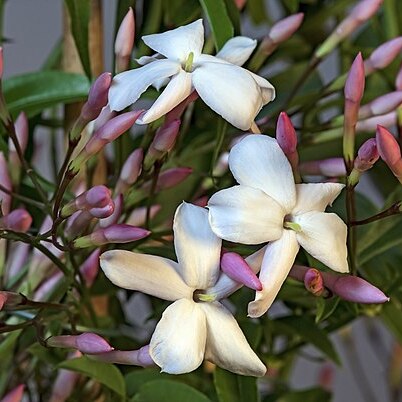Trees or erect or scandent shrubs, evergreen or deciduous. Branchlets terete or angular and grooved. Leaves opposite or alternate, rarely whorled, simple, 3-foliolate, or odd-pinnate; petiole usually articulated. Inflorescences basically cymose, in panicles, racemes, corymbs, umbels, or heads; bracts subulate or linear, sometimes leafy. Flowers bisexual, usually heterostylous, usually fragrant. Calyx campanulate, cupular, or funnelform, 4-16-lobed. Corolla white or yellow, rarely red or purple, salverform or funnelform; lobes 4-16, imbricate in bud, sometimes doubled in cultivation. Stamens 2, included, inserted about middle of corolla tube; filaments short; anthers dorsifixed, introrse. Ovules 1 or 2 in each locule. Style filiform; stigma capitate or 2-lobed. Fruit a berry, didymous or one half aborted. Seeds without endosperm; radicle downward.
Shrubs, generally climbing or scrambling. Leaves simple or compound, opposite, whorled, or spirally arranged. Flowers solitary or in generally few-flowered simple or compound cymes. Calyx with a more or less campanulate tube and variously developed lobes. Corolla hypocrateriform, with a usually slender essentially narrow-cylindrical tube surmounted by 4–10 imbricate lobes; often sweet-scented and white, yellow, or flushed pink. Stamens 2, inserted high up in the corolla tube on short filaments. Ovary bilocular; style slender; stigma capitate, clavate, or bilobed; ovules generally 2 in each loculus. Fruit a berry, deeply bilobed (didymous) or simple by aborption of one lobe. Seeds solitary in a lobe, erect; endosperm absent.
Erect shrubs, scramblers or lianes, usually evergreen. Shoots generally angled and green. Lvs generally opposite, sometimes alternate, imparipinnate or simple; leaflets entire. Fls usually in terminal or axillary, bracteate cymes, sometimes solitary, ☿, often fragrant. Calyx 4-9-lobed, campanulate or funnelform, often minute. Corolla 4-9-lobed, convolute in bud, usually salverform with a narrow-cylindric tube, generally white, sometimes yellow, pink or red. Stamens 2, included, epipetalous; filaments short. Style short or long; stigma ± 2-lobed. Fr. a 2-lobed berry, usually black, each carpel with 1-2 seeds.
into a short apicule; stigmatic style branches fusiform, included or long-exserted, the ovary hemispherical or truncate, the 2 carpels mostly demarcated by a sulcus or separating plate of nonaccrescent tissue, the ovules 1-4 in each locule, mostly ascending, amphitropous, sometimes pendulous and anatropous. Fruits of 2 drupe-lets, connate or divaricate, juicy or fleshy, 1-2-seeded, one drupelet often abortive; pyrenes with little endosperm.
Leaves opposite, verticillate or alternate, simple or compound, glabrous or hairy; acarodomatia sometimes present in axils of lateral nerves on lower leaf surface.
Ovary bilocular; style slender, either exceeding corolla tube or half as long (flowers heterostylous); stigma bilobed but lobes remaining together.
Corolla white and often pink on reverse, or yellow, hypocrateriform, glabrous; lobes imbricate, (4)5–13.
Inflorescences few– to many–flowered, cymose, or flowers solitary; flowers sweetly scented.
Stamens 2, inserted in or at mouth of corolla tube; filaments short, anthers introrse.
Fruit a deeply bilobed 2–seeded berry, often one lobe aborting.
Calyx with cup–shaped tube and (4) 5–15 teeth.
Shrubs, often with climbing habit.
Seeds without endosperm.

